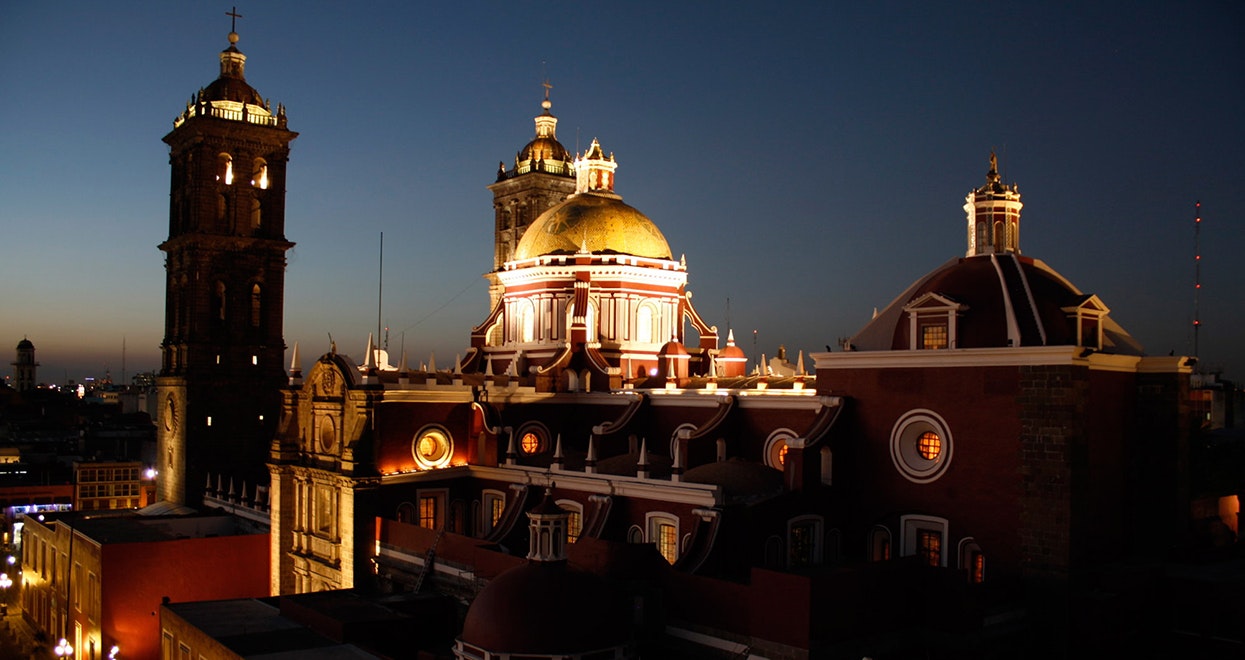
Only 60 miles from Mexico City, the dynamic capital teeming with nearly nine million residents, Puebla is worlds apart. Arriving in this city in the shadow of two volcanoes, you may even feel like you’ve gone back in time. Almost every block of the intact colonial-era street grid includes examples of masterpieces of Baroque design, including many in the over-the-top Churrigueresque style unique to Mexico. Indeed, when location scouts for the movie Fridawere looking for a place to shoot the film that resembled Mexico City at the turn of the last century, they chose Puebla.
The city is not just a feast for the eyes, however. Puebla has rich culinary traditions, including its renowned mole sauces, which incorporate dozens of herbs and spices and, famously, chocolate. It’s the original and largest producer of the grain amaranth and the birthplace of chiles en nogada—a stuffed poblano chili with a walnut sauce.
With United Vacations’ itinerary to Puebla, you’ll have time not only to sample the local flavors of the city, but also to explore the surrounding villages, pre-Columbian sites, and natural attractions.

After you land at the Puebla Airport, you’ll pick up your rental car and drive a half-hour to your preferred hotel. The 200-room InterContinental Presidente Puebla is a grand contemporary hotel with a restaurant, a lobby bar, a spa, and an outdoor pool. The recently refurbished rooms have private balconies and design elements inspired by Mexican crafts. Right next door, the Holiday Inn Express Puebla has remarkably spacious rooms, an indoor pool, and a breakfast bar included in the room rate.
After you are settled, head about 15 minutes to the heart of Puebla to wander its historic streets. A good starting point is the cathedral, which was built over nearly a century, from 1575 to 1649, when it was consecrated. Puebla is known among Mexicans as an especially pious city, and centuries-old convents and churches can be found on every street. If you have a sweet tooth, you’ll want to wander along Avenida 6 Oriente, where a number of stores selling traditional Mexican candies. Camotes are a local favorite, made from sweet potatoes. A number of religious orders produce cookies and caramels following age-old recipes and their sweets can be purchased here as well.
For dinner, you’ll want to try the city’s most famous dish, mole poblano. Ask any locals which restaurant serves the best version, and you may provoke a heated discussion. One contender on many short lists is the Casona de la China Poblano. The chef will invite you into the kitchen for a lesson on how moles, which incorporate dozens of herbs and spices, are created before you sit down to your meals.

After breakfast, drive some 35 minutes south to Atlixco. Like Puebla, the city was founded in the 16th century, though many of its most important churches date from the 18th century, and reflect the local variation on Baroque design. One notable example is the Parroquia de Santa María de la Natividad on the town’s main plaza. The Ex-Convento de Nuestra Señora del Carmen is just two minutes on foot from the town’s zócalo. Construction of this complex of buildings for an order of Carmelite nuns began in the 16th century. They’ve since been used for a number of purposes including as a school and army barracks; today they house a cultural center.
After you’re done exploring Atlixco, take a short drive outside of town to Las Calandrias for lunch. This hacienda with landscaped grounds is a tranquil setting for a spread of local dishes. Another option on the road back to Puebla is Palmira, known equally for its excellent moles and its lush gardens.
Once you have refueled, drive another half-hour south to the town of Huaquechula. It predates Mexico’s colonial era, with a settlement here since 1100 C.E. The city is famous for its annual Day of the Dead (November 2) celebrations and altars. But at any time of the year the Ex-Convento Franciscano is the most notable landmark. This convent was built for an order of Franciscans beginning in 1570 and stands next to the town’s zócalo.
After your visit, return to Puebla, roughly an hour’s drive.

You’ll head in the opposite direction to visit the village of Tepeyahualco de Hidalgo, just over an hour northeast of Puebla. Its star attraction is Cantona, the largest archaeological site in the state of Puebla. The Olmecs constructed the city during their Late Classic period (600 to 1000 C.E.) and it’s believed to have once extended over more than five square miles. Temples, palaces, and more than 24 ball courts have been identified here, in what was one of the most developed urban centers in this part of Mexico. You can learn more and glimpse artifacts at the Museo de Sitio de Cantona near the archaeological digs.
Spend a little time in the present-day town of Tepeyahualco itself, and have a late lunch at Restaurante 52, a local favorite. Take a detour to stop at Amozoc de Mota, just north of Puebla. The Parroquía de Santa María de Asunción presides over the town square while many stores sell beautiful silverwork, a craft that dates back to the 16th century here.
